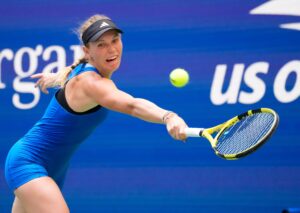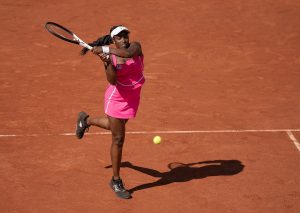The first thing to say about a list of great male British tennis players is that it is a fairly short one. Moreover, there are big gaps, in particular the 76-year gap between Fred Perry winning his last Major (at the US Open in 1936) and Andy Murray winning his first (also at the US Open in 2012). Now, as Murray announces his plan to retire from tennis this year, Last Word on Tennis considers exactly where he ranks among the greatest British male players ever.
Here, then, are the five greatest male British tennis players.
-
5. GREG RUSEDSKI (CAREER HIGHLIGHT: REACHING US OPEN FINAL IN 1997)
There are still some people who would insist that Greg Rusedski should not be included on any list of great male British tennis players, as he originally hailed from Canada. However, he was eligible to play for Britain because of his English mother and after switching allegiance and taking up British citizenship in 1995, he eventually won the admiration, if not quite the love, of most British tennis fans.
Rusedski’s greatest achievement was undoubtedly reaching the US Open Final in 1997, where he lost in four sets to Australia’s Pat Rafter. Unfortunately for Rusedski, his run to that final, the highlight of which was beating the 1996 Wimbledon Champion Richard Krajicek in straight sets in the quarterfinals, coincided with tragic events in Britain, namely the death of Princess Diana and her lover Dodi Fayed in a car crash in Paris. Consequently, he never quite made the impact in his adopted home that he might otherwise have done. Nevertheless, finishing runner-up in New York took him to a career high of No.4 in the world, which would have been utterly unthinkable for any male British tennis player during the previous fifty years.
-
4. BUNNY AUSTIN (CAREER HIGHLIGHT: FINISHING RUNNER-UP IN THREE MAJOR FINALS)
Henry Wilfred Austin, to give “Bunny” his full name, was one of Britain’s finest male tennis players between the two World Wars; although he never managed to win a Major, he finished runner-up in one three times and reached a career high of World No.2 in 1931. Although at that time the rankings were unofficial (it was more than 40 years before the ATP introduced its official computerised world rankings), that still gives some idea of Austin’s prowess, as he was ranked behind only the great American, Bill Tilden.
Austin twice reached the Wimbledon Men’s Singles Final, in 1932 and 1938, losing to Ellsworth Vines and the great Don Budge (the first man to win the true “Grand Slam,” by winning all four Majors in one year) respectively. However, he was not just a grass specialist, as shown by his reaching the 1937 French Open (then called the French Championships) final, where he lost to Germany’s Heinrich Henkel. And as for that famous nickname, apparently it came from a cartoon rabbit that he was particularly fond of as a boy.
-
3. TIM HENMAN (CAREER HIGHLIGHT: REACHING FOUR WIMBLEDON SEMI-FINALS)
Like Greg Rusedski and Bunny Austin, Tim Henman never won a Major title. In fact, unlike Rusedski and Austin, he never even reached a Major final. Nevertheless, he still deserves to be ranked above them both on this list for almost single-handedly reanimating British men’s tennis after decades of defeat and disappointment.
It is easy to forget now, in the wake of Andy Murray’s achievements, quite how dreadful British men’s tennis was for most of the second half of the 20th century. There were the occasional, isolated achievements, such as when John Lloyd reached the Australian Open Final in 1977 and lost a thrilling five-set match to America’s Vitas Gerulaitis (Lloyd came from two sets down to square the match at two sets all, before losing the fifth set 6-2). Nevertheless, prior to Henman’s arrival in the mid-1990s, no British male player had enjoyed a truly successful tennis career since before the start of World War Two.
Henman changed all that, reaching four Wimbledon semifinals (and also reaching the last four at both the French Open and the US Open in 2004), and matching his contemporary, Greg Rusedski, by reaching a career-high world ranking of No.4. And if rain ultimately robbed him of the chance to reach the 2001 Wimbledon Final (he eventually lost a semifinal against Goran Ivanisevic that was dragged out over three days because of rain delays), the man himself remained charmingly philosophical about his overall achievements. As he has often pointed out, he would always take his decade of near-greatness ahead of a one-time, one-off Major win (such as that of Gaston Gaudio, the eventual winner of the 2004 French Open) any day of the week.
Tie-1. FRED PERRY AND ANDY MURRAY (CAREER HIGHLIGHTS: MULTIPLE WIMBLEDON WINS)
In the immediate aftermath of Andy Murray’s emotional announcement that he will be retiring from tennis this year, it has been all too easy to hail him as unquestionably the greatest male British tennis player “of all time” (a phrase that is often used in any discussion of sporting greatness, which really means the last 150 years or so of organised sport). However, that would be to do a tremendous disservice to Britain’s other truly great male British tennis player, Fred Perry. In fact, perhaps the greatest accolade that can be paid to Andy Murray is that he deserves to be ranked right alongside Perry, despite winning far fewer Majors (three to Perry’s eight).
Of course, it is always impossible to compare sporting champions from different eras, not least because they obviously never competed against each other. As is often said, the best that any sportsman or woman can achieve is to be the best of their own era. Fred Perry was unquestionably the best tennis player of his own period (the mid-1930s), reaching the position of unofficial World No.1 in 1934. Murray, of course, also reached World No.1, after his phenomenal run at the end of 2016, and if he could not stay there for as long as Davis did, well, Davis was not competing against the three men who are now deservedly regarded as the three greatest male players ever, namely Federer, Nadal and Djokovic.
Ultimately, it was at Wimbledon, the greatest and most historic tennis tournament in the world, that both men forged their stellar reputations. Perry won the Wimbledon Men’s Singles title three times in a row between 1934 and 1936, and if Murray could not quite match that hat-trick he still won Wimbledon twice, in 2013 and 2016. And of course Murray was always playing, as it were, in Perry’s shadow. In fact, prior to Murray winning his first Wimbledon title in 2013, it was considered virtually impossible for a British man to win a Major on home soil (or grass), such was the incredible pressure heaped upon them to emulate Perry, which obviously only grew with each passing year.
The fact that Murray ultimately matched Perry and won Wimbledon, not once but twice, despite facing both greater champions than Perry faced and infinitely greater pressure from the public and the media, means that he truly deserves to be ranked alongside Perry, who statistically (with those eight Majors) is the most successful British male player ever. Together, they are the twin titans of British men’s tennis and it might be another half-century or more before we see anyone approaching their like again.






